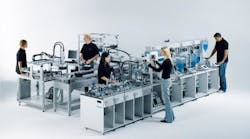As advanced manufacturing (AM) moves into the fourth industrial revolution, more commonly known as Industry 4.0, industry professionals increasingly need to become well-versed in multiple disciplines within the automation arena, rather than limit their skills to one area of expertise.
Through its Festo Didactic branch, Festo looks to widen the skill sets of student engineers and specialists through various learning systems, products, and instructional material that encourage hands-on study and discovery. The firm partners with two- and four-year colleges, companies, and education programs worldwide to create a skilled workforce that hopes to advance manufacturing into the new industrial revolution.
Festo Didactic's dedication to providing hands-on education to workers and students stems from the corporation's experience with global industrial automation and advanced manufacturing. Tony Oran, Partnership Manager, highlights Festo Didactic's focus on fluid power, especially pneumatics.
“Pneumatics is at the heart of advanced manufacturing and automation,” says Oran. “While electric automation components are also growing, pneumatics specializations can tie into many different paths.”
Festo Didactic offers its brand of training sets, textbook materials, simulation software, and other course materials to colleges and companies. It also established a range of learning centers internationally and across the U.S., where individuals can plan out classroom and lab-floor designs, talk to industry consultants, and receive global training.
Festo Didactic is also dedicated to STEM education for high school and middle school. "Early STEM education is definitely a main goal for Festo Didactic right now. We look to revamp STEM education so that it is less academic and more hands on. By offering a bionic approach to automation, we hope to reach out to all types of learners and bring some attractiveness to STEM and AM," says Oran.
The company partners with organizations like WorldSkills, offering its "smart factory" training sets so that students can compete with one another and put their skills in fluid power, electronics, mechatronics, and other industrial topics to the test.
Hardware
Hydraulic and pneumatic training sets extend from beginner level to more specialized sets that combine fluid power with topics like electropneumatic controls. Training sets broaden the skill sets of experienced fluid-power technicians and engineers, enabling them to apply fluid power to contemporary factory-automation practices.
Festo Didactic also offers simulation programs, such as FluidSim. Geared toward fluid-power applications, the sofware defines components using ISO symbology and enables users to design open or closed hydraulic and pneumatic circuits. Other features enable students to learn how to manage efficiency and power consumption.
In addition, FluidSim can be paired with the training sets offered by Festo Didactic, or any other sensor-equipped fluid-power system via a USB interface. FluidSim will respond to a system in real-time so that users can monitor and control the operation of their training sets. Fluid-power engineers can also use the software as a platform to familiarize themselves with function blocks and relay logic, building programming knowledge for contemporary program-logic computers (PLCs).
"FluidSim will help engineers become more comfortable with digitization that will become prevalent in Industry 4.0," says Olan.
Partnerships
One main mission of Festo Didactic is to reach out to schools, programs, and companies so that they may gain access to their "smart factory" training systems. By using Festo materials or hiring Festo trainers to conduct courses, students and professionals may acquire certification for learning a hands-on skill. According to Oran, Festo's teaching methods and materials consist of 30% theory or book knowledge, and 70% hands-on experience with functioning systems.
"Simulation is also an important part of building a competent workforce," says Oran. "Festo Didactic brings connected learning to the table, combining theory and simulation while building hands-on skills."
Festo courses are preceded with knowledge tests and finish with a final performance test. Oran also adds that schools can align other industry-standard certifications to the Festo curricula, since Festo Didactic material follows ISO symbology and standards to teach students about components and design practices.

